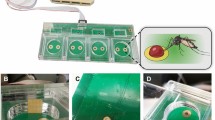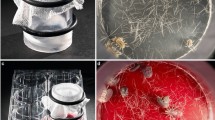Abstract
SEVERAL types of feeding chambers have been devised1 for in vivo observations on the feeding mechanism of blood-sucking arthropods, but these chambers, designed to accommodate relatively large creatures (triatomine bugs, tsetse flies and ticks), have proved to be unsuitable for small insects and acarines, such as fleas, lice and mites. Our interest in the mechanism of disease transmission by the flea led us to construct a small feeding apparatus by means of which we have been able to undertake extensive observations on the uptake of blood by this insect from the tissues of its host.
This is a preview of subscription content, access via your institution
Access options
Subscribe to this journal
Receive 51 print issues and online access
$199.00 per year
only $3.90 per issue
Buy this article
- Purchase on Springer Link
- Instant access to full article PDF
Prices may be subject to local taxes which are calculated during checkout
Similar content being viewed by others
References
Lavoipierre, M. M. J., Dickerson, G., and Gordon, R. M., Ann. Trop. Med. Parasitol., 53, 235 (1959). Gregson, J. D., Acta Trop., Basel, 17, 48 (1960).
Griffiths, R. B., and Gordon, R. M., Ann. Trop. Med. Parasitol., 46, 311 (1953).
Wenk, P., Zool. Jb., 73, 103 (1953).
Author information
Authors and Affiliations
Rights and permissions
About this article
Cite this article
LAVOIPIERRE, M., HAMACHI, M. An Apparatus for Observations on the Feeding Mechanism of the Flea. Nature 192, 998–999 (1961). https://doi.org/10.1038/192998a0
Issue Date:
DOI: https://doi.org/10.1038/192998a0
This article is cited by
-
Feeding Mechanism of Blood-sucking Arthropods
Nature (1965)
Comments
By submitting a comment you agree to abide by our Terms and Community Guidelines. If you find something abusive or that does not comply with our terms or guidelines please flag it as inappropriate.



